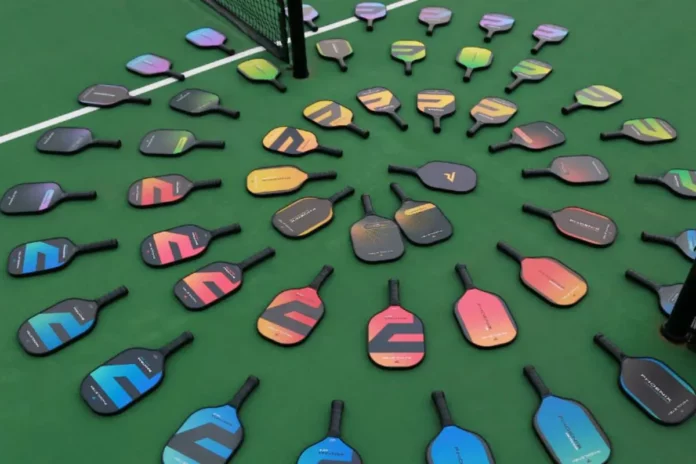Mastering Pickleball Paddle Stacking: In the vibrant world of pickleball, a sport that thrives in community settings, particularly on public courts, understanding paddle stacking etiquette is vital. While pickleball offers a fun and social experience, players must grasp the nuances of how they interact on the court. Since each venue may enforce its own set of specific rules, it is always wise for players to engage in conversation with locals to discover the best practices tailored to their environment.
Paddle stacking etiquette serves as a foundation for maintaining an enjoyable and organized atmosphere on public courts.
Why is Paddle Stacking Important?
Paddle stacking establishes an organized turn-taking system, promoting fair play and affording every player the opportunity to participate and engage with fellow pickleball enthusiasts. Here are several reasons highlighting its importance:
- Fair Play
By creating a structured way to take turns, paddle stacking ensures that all players have a fair chance to enjoy the game. - Time Management
With a clear understanding of when to step onto the court, matches flow smoothly, resulting in quicker games and minimizing wait times for those eager to join. - Community Spirit
Following paddle stacking etiquette fosters respect and camaraderie among players, enhancing the social aspect of the game. Open communication and patience contribute to enjoyable matches, making every encounter memorable.
For those looking to enhance their pickleball experience, becoming a member of a local pickleball community can lead to fair play, efficient game flow, and a strong sense of community spirit on the courts.
Methods for Stacking Paddles
There are various commonly used methods for paddle stacking, each accompanied by its own set of etiquette. Here are some popular formats players may encounter:
- 2 on, 2 off
In this arrangement, two players face off against two others, maintaining four players on the court. After a designated time, players switch, fostering participation and skill-building in a lively environment. - 4 on, 4 off
Players form two teams of four, with the winning team remaining on the court while the losing team rotates out. This format encourages greater interaction among larger groups of participants. - Winners Stay
In this format, winners remain on the court, creating excitement as challengers eagerly await their turn. Keeping an eye on sidelined players ensures fairness and enjoyment for all involved. - Challenge Court
The challenge court format allows players to place paddles in a designated area to contest current games. Winning grants control of the court, appealing to competitive spirits, though it may increase wait times. - Everyone Rotates
This method guarantees equal playtime for participants. After each game, players rotate, ensuring that no one dominates the court for too long, thus fostering social interaction and connection.
Key Considerations for Players
Engaging in pickleball requires an understanding of and adaptability to the specific environment and community. Here are several key considerations players should keep in mind:
- Respect Local Rules
Each court may enforce unique paddle stacking rules, such as specific rotation systems or designated challenge courts. A brief conversation with local players can provide insight into these norms. - Communicate
Clear communication creates a positive atmosphere. Players should inform others when they are ready to play and politely inquire about local guidelines, enhancing enjoyment and promoting friendly interactions. - Practice Patience
All players desire an opportunity on the court, making patience essential. Maintaining a positive attitude while waiting or observing can enhance the overall experience and foster a welcoming atmosphere. - Be Inclusive
Encouraging newcomers and welcoming players of varying skill levels fosters community spirit. Pickleball flourishes through inclusivity, enhancing fun for all participants and creating lasting connections through positive competition.
When to Apply Paddle Stacking Etiquette
Understanding when to implement paddle stacking etiquette is crucial for a positive experience, particularly during busy periods such as weekends or tournaments. Adhering to these guidelines helps maintain order and ensures fair play.
By observing how others stack their paddles and engage on the court, newcomers can glean valuable insights into the local culture. Engaging in discussions about court etiquette not only fosters connections but also builds relationships within the pickleball community.
Respect, patience, and inclusivity are paramount in creating a welcoming atmosphere for all players. Embracing these practices enhances enjoyment and nurtures a sense of belonging among participants.
Avoiding Common Pitfalls
Being mindful of frequent mistakes can greatly improve the pickleball experience. Like any sport, respecting the environment and the players around one is vital. Here are some common pitfalls players should avoid:
- Ignoring Local Norms
Failing to inquire about local rules can lead to misunderstandings and frustrations. Taking time to learn and adapt promotes a more vibrant environment for everyone involved. - Overcrowding the Court
Allowing too many players to stack paddles creates confusion and prolonged waits. Adhering to established formats ensures good gameplay and enhances the overall experience for all players. - Disrespecting Waiting Players
Neglecting waiting players while focusing solely on gameplay can diminish community spirit. Demonstrating courtesy and awareness to those eager to join fosters positive experiences for all involved.
News in Brief: Mastering Pickleball Paddle Stacking
Paddle stacking etiquette on public courts plays a crucial role in fostering fair play and community spirit. Players are encouraged to understand local rules, communicate effectively, and build inclusivity, particularly during busy times. By adhering to various paddle stacking methods and avoiding common pitfalls, participants can enhance their overall experience on the court while building meaningful connections within the pickleball community.
ALSO READ: Why Pickleball Paddle Inspections Matter in the World of Pickleball

